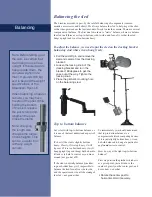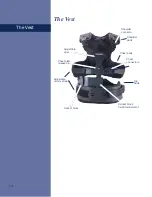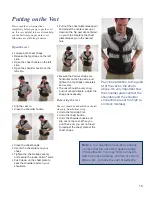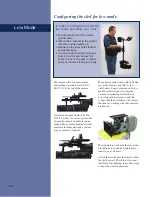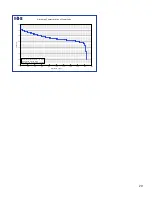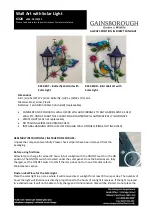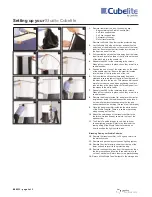
24
Dynamic Balancing
B
M
M
M
B
B
Dynamic Balancing the Flyer-LE
™
A Steadicam sled is in dynamic balance
when the center post remains vertical as
the sled is panned (and this is critical) at
any and all panning speeds.
Dynamic balance is extremely important
for precise operating and also for whip
pans.
For each arrangement of camera, monitor
position, post length, accessories, etc.,
there are many possibilities for statically
balancing the Steadicam.
However, for each arrangement of
camera, monitor position, post length,
accessories, etc., there is only one
combination that balances the sled both
statically and dynamically. There is some
leeway as to the required precision of
dynamic balance. What is acceptable
depends upon the operator and the
situation.
Dynamic balance with the Flyer-LE can
very easily and quickly be achieved by
the trial and error method.
In all cases, when a sled is in dynamic
balance, both the camera’s c.g. and the
battery’s c.g. will be to the rear of the
centerline of the center post. This rule
gives you some point to begin balancing
the Steadicam.
Three figures to study for understanding dynamic balance
The top figure looks like the Model One or the SK Steadicams. The camera c.g. is
centered over the post; the monitor and battery are on the same horizontal plane, and
their common c.g. is in the post. This unit is in dynamic balance and pans flat.
The second figure has the monitor raised a bit. This looks like most Steadicam
configurations, including the Flyer-LE, in either high or low mode. Note that the battery
c.g. is closer to the post, and the camera c.g. has moved to the rear. Why?? See the third
figure.
In the third figure, the monitor has been raised all the way up in front of the camera. It’s
absurd, of course, but it makes a point. Now the common monitor and camera c.g. is over
the post, and the battery’s c.g. is directly under the post.
So you can see that as the monitor is raised, the camera c.g. must move to the rear and
the battery c.g. must move towards the post. With the Flyer-LE, the monitor is typically
raised above the battery – and with 2 batteries, the monitor must be above the battery for
dynamic balance. Therefore camera is always to the rear of the centerpost.
It typically works out that the camera c.g. is pretty close to 1/2 inch (12mm) to the rear –
a bit more if the camera is light or the monitor is higher, and somewhat less if the camera
is very heavy or the monitor is lower.



